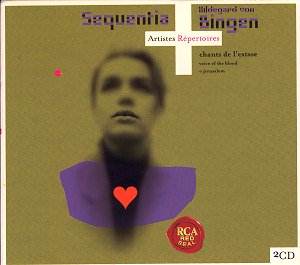The
1990s saw the rise of interest in one of the most intriguing personalities
of the Middle Ages: Hildegard of Bingen. Several factors contributed
to this fascination. She was an abbess, raised and living in a
convent, but who wrote treatises on all kinds of subjects and
corresponded with some of her most famous contemporaries, something
one doesn’t expect from a woman in the Middle Ages. Composing
music was certainly something which wasn’t associated with medieval
women. In addition to that, her music seems to have a personal
touch, which is lacking in most sacred music of the time. And
some of her texts seem to reflect a more open mind than is associated
with her time, especially considering her position as abbess and
therefore subordinate to the authority of the Church.
This
fascination led to attempts to associate Hildegard, her thinking
and her writings with 20th century concepts and ideas. She was
presented as a pioneer of the feminist movement, and supporters
of ‘New Age’ saw her as someone whose ideas foreshadowed their
own.
But
all these attempts are doomed to fail, for the simple reason that
they are highly anachronistic. Sure, Hildegard is a remarkable
and in many ways unique figure, who was clearly different from
most people, in particular most women, of her time. But that doesn’t
mean she was a rebel. There is no sign in Hildegard's writings
nor in the texts she set to music that she questioned the authority
of the Church or its doctrines. The second CD in this set, which
contains a number of hymns to the Virgin Mary, gives evidence
of that.
There
are many recordings of Hildegard’s works. Some of these reflect
the attempt to link Hildegard to – in particular – the New Age
movement, and mysticism in general. Sequentia has recorded almost
all of Hildegard's works, and these recordings show nothing of
this kind of anachronism. This ensemble always painstakingly prepares
recordings with historical research, and always tries to put the
music in its proper historical and spiritual context.
The
first CD contains music which refers to the life of St Ursula
of Cologne, who was supposedly tortured by barbarian soldiers,
with her partners, the Eleven Thousand Virgins. St Ursula developed
cult status, and Hildegard strongly identified with her. This
is reflected in the music, which is very personal, almost exalted.
Sequentia delivers this character very convincingly. In comparison,
the music on the second CD is more restrained. It was written
to celebrate the building of a new church for Hildegard’s congregation
on the Rupertsberg, which once accommodated a convent dedicated
to St Rupert. The hymns here are devoted to him, to the Virgin
Mary and to the Church, for which Jerusalem is used as a metaphor.
The performances are exemplary.
The
ensemble contains two separate vocal groups of women and men respectively.
They never sing together, which is historically justified, as
is the rather sober use of instruments.
This
is a reissue of previously released recordings on Deutsche Harmonia
Mundi. This budget release is a great opportunity to get to know
the music of Hildegard. Unfortunately the programme notes are
very brief and also hard to read: they are in very small letters
on a coloured background. Even the titles are difficult to decipher,
and the texts of the songs are not printed, which is a serious
omission.
Johan
van Veen


